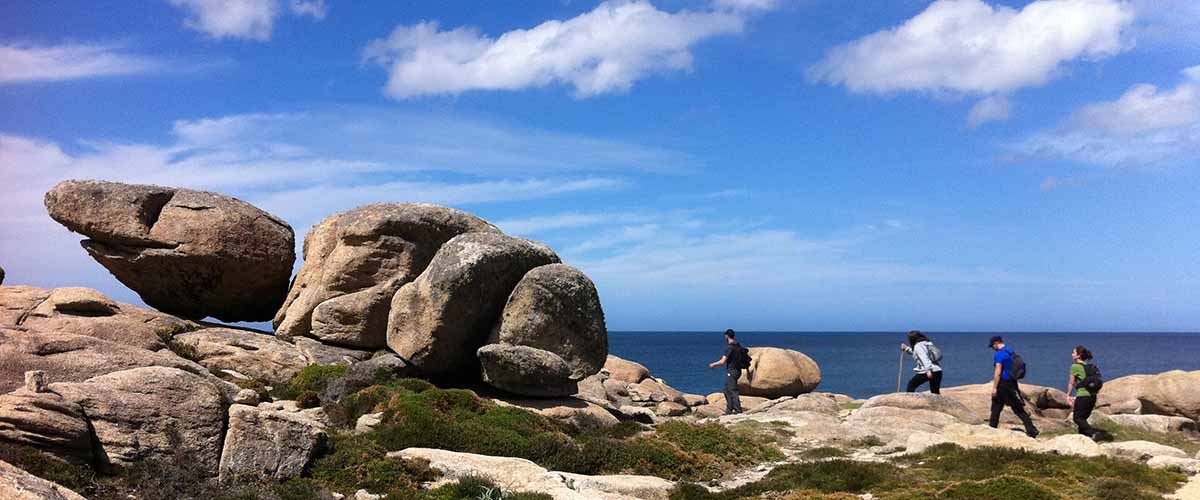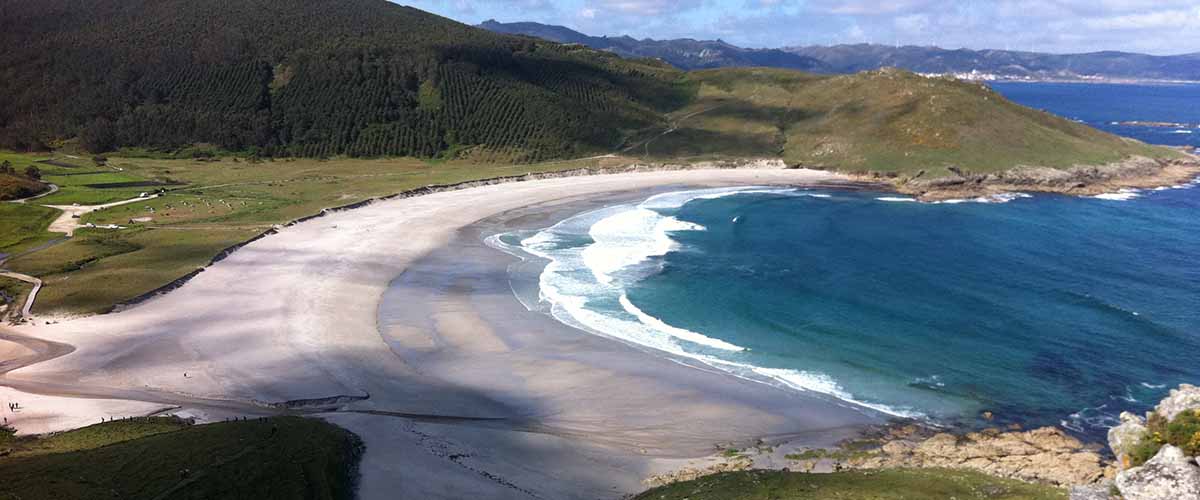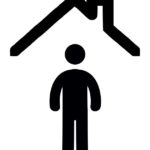ROUTE LAXE – AROU
TUESDAY, MAY 27
This stage will take us along the coast of Laxe, visiting its spectacular and wide open beaches to the Atlantic Ocean. The Crystal Beach, the views of Soesto from the Peñón do Castro and the Traba Lagoon complete a very fun stage beginning. But the end is fantastic: a struggle of millions of years between the sea and the stone that has its maximum expression in the Cuello da Señora, where we will walk among the great rocks, remembering Man, the German who was left here forever by a walk like this, fully integrated into the landscape.
Make your reservation for the GWF Camiño dos Faros Program
In the Port of Laxe we begin this stage that will take us to Arou. The coastal fleet is preparing for another hard day at sea. Upon returning from fishing, catches of the day are auctioned in the fish market.
Built at the end of the XIV, the Church of Santa María da Atalaia is of great historical and artistic value. Clear example of the Gothic sailor that appears in many churches of the Galician coast, from the time of its construction some sculptures are preserved. Of a single nave with square apse, its facade is decorated with images of the Virgin. Inside the church there are several tombs from the 13th century of the Moscoso that ruled these lands. The baroque altarpiece that existed on the main altar was destroyed by lightning in 1955, leaving a unique stone altarpiece in sight. In the atrium you can see the “cruceiro” and we have a great panoramic view of the port and the beach of Laxe.
We continue along the streets of Laxe on the way to Monte da Insua, which will take us to the lighthouse. We leave to our right the estuary of Corme and Laxe. As you know, O Camiño dos Faros is special that at every moment of the route you see the road you have already walked and the goals you have to reach.
On the Monte da Insua is the Laxe Lighthouse. Built in 1920 it is exactly the same as Roncudo, a simple cylinder covered with white tiles. But its situation, like the rest of lighthouses of this route, is privileged. On its feet, Arnela Beach was wrecked in 1972, a Corme ship that was arriving at its port when it hit the rocks of Punta da Insua, saving only two crew members. This sea does not forgive.
Near the lighthouse we can see the bronze sculpture ‘A Espera‘, a tribute to all the men of the sea and their women, who are looking forward to their arrival in port. The views are spectacular. On the right, the entire Corme-Laxe estuary. On the left, the entire open sea coast we have to walk. In the background, you can see the Penal de Veo and the dune of Monte Branco, half of O Camiño dos Faros.
The sea constantly strikes against this Monte da Insua. On the trail we were already checking it but when we reached the Furna da Espuma, that force becomes white foam. You have to be very careful when passing, but if you have a day with the right wind conditions, it is a great show.
This section ends at the Crystals Beach. Sometimes, nature is capricious and the sea always returns what is thrown away. In this area of Laxe there was an old garbage dump where bottles and other containers were thrown. On these cliffs of perpetual waves, the sea collected those remains and returned them polished in a work of art on this small cove. Crystals of all colors come together with small shells in this curious corner. Make a stop, enjoy, take pictures … but remember: It is forbidden to take the crystals from the beach.
The next objective of this Camiño dos Faros is the Rock of Soesto. After passing the cemetery we take the deviation to the right that leads us along a narrow path through which we walk the Enseada de Baleeira. The sea breaks at all points and we walk on it, listening to it and feeling it.
We begin the ascent from the Morelo to reach the Rock of Soesto. The ascent is short and is the only difficulty of the stage. From the top we have two other stunning panoramic views. To the north all the Roncudo, with Corme in the background. In the foreground all the Monte da Insua we had surrounded to the lighthouse of Laxe, the Crystals Beach and the Enseada da Baleeira. To the south, we see Soesto beach with the sea breaking hard and, in the background, the Catasol point … a privileged viewpoint !. The stop can be as long as you want, the stage is the shortest of the way and it is worth squeezing it.
We descend from Peñón do Castro to Soesto Beach, with this feeling of freedom that Costa da Morte offers you. But beware, the descent is the most dangerous part of the section, passing through smooth stones that may be slippery. Be careful. The beach is fine white sand, open to the sea, windy and quite swell, being the place chosen by many surfers to practice their favorite sport. Crossing the small stream of Soesto we stopped to take a picture … the dunes show all their tapestry of colors … the shapes are perfect … O Camiño dos Faros is an art gallery …
Leaving Soesto we arrive at the Point of Catasol, where we watch the waves. In this part of Camiño dos Faros, the sea begins to get much more serious, a spectacle for the senses. The path to Traba takes us on a dirt track that lets us relax our legs a little, after the million stones that we carry on the route … and the ones we have left!
Along the way, between the points, there are small coves such as Castrallón Beach and larger coves, such as Arnado Beach. In front of it we have several boulders, among them the islet of Ataín, witness of several shipwrecks and already, in the direction of Traba, Teixoeira Island. We continue with a sea that is nice to watch …
This natural area of Traba, formed by the beach and the lagoon, is full of natural beauty. The legend says that under its waters the city of Valverde is buried by divine punishment. The wide Praia de Traba of 2650 meters open to the sea has a dune complex that separates it from the lagoon of great ecological value.
We reach the natural space of the Traba Lagoon, which we walk through the wooden walkway. The contribution of fluvial matter and marine currents are forming a sandbar that closes the bay and an arrow-shaped beach. From that moment there is another phase, in which sand and silt deposits fill the edges of the lagoon, decreasing its depth and allowing the fixation of vegetation adapted to these conditions that, in turn, cause more sediment deposition and more land are being discovered. The communication with the sea is done through a narrow channel of approximately 5 m wide and 400 m long
The vegetation is typical of these biotopes: the lagoon is almost entirely surrounded by a dense carrizal (Phragmites australis), there are also swords (Typha latifolia) and a juncal (Juncus maritimus) where the salinity of the water is already noticeable. As for fauna, in the dense carrizal they find refuge for their nesting various birds such as the river hen (Gallinula chloropus), the water scratch (Rallus aquaticus) and the unicolor fulepa (Locustella luscinioides). The Anatidae are also well represented.
However, the interest of this natural area is focused on the large number of quotes of strange winter birds in these latitudes: American pilro (Calidris melanotos), small yellow-legged bilurico (Tringla flavipes), American weeping gull (Larus atricilla), Bonaparte seagull (Larus philadelphia), shady carrán (Sterna fuscata), galiñola pinta (Porzana porzana), small galiñola (Porzana silly), common galiñola (Porzana pusilla), American abetoro (Botaurus lentiginosus) and reed writer (Emberiza schoeniclus), between others.
At the end of the walk through the lagoon, we arrive at the small village of Mórdomo, where the Bar Os Espiños is located, in addition to a recreational area with benches and tables, the perfect place for the stage provisioning.
From Mórdomo there is a path that leads us through the end of the Traba Beach towards another of the most spectacular sections of this Camiño dos Faros: O Cuello da Señora. All this coast in the direction of Camelle takes you to the story of Gulliver in the world of rocks, another new landscape on the route. Large rock formations of this coast, molded by the continuous action of water and wind that leave us surprising figures.
Large granite rocks of all shapes and sizes … The shapes are increasingly twisted and the points of support between those tons of stone are getting smaller … Take this stretch calmly, it is well worth enjoying another unique landscape of this very complete Camiño dos Faros.
This section ends at the Coido de Sabadelle, which is supposed to be the germ of the current Camelle. It is a cove formed of large granite bowling, which we will have to be careful when crossing them. The stage is being spectacular, short but very tasty.
Camelle is a small and beautiful seaport that preserves the charm of yesteryear in its streets. We are entering the heart of the Costa da Morte, one of the most wrecked coastal stretches worldwide. Its people, mostly dedicated to fishing, are reputed to be sea people who, risking their lives, helped in the rescue of the many shipwrecks on these coasts.
Of one of those shipwrecks, the one of the English ship City of Agra shipwrecked in 1897, the bell is conserved in the church of the Holy Spirit. This heroic attitude of the inhabitants of Camelle and Arou in the rescue led them to be decorated by the English crown. In 1898, the Barbeito Rescue Station was installed, which, in addition to providing assistance, also saved cargoes and scrapped damaged ships. Because Camelle was the place where the shipwrecked people went and were given the first attention, there were insurance companies, customs agents and consuls from different countries.
At the entrance of the small cove of Camelle there were underwater rocks that were called A Pedra do Porto which, with the construction of the dock, were dynamited in 2005. There, at the beginning of the twentieth century, three boats ended their voyages: the Yeoman ( 1904), Natalia (1915) and Boris Sheboldaev (1934), the last-generation Russian oil tanker that, in the middle of a storm surge and under the fog, went to hit the stone. Despite going empty, this accident caused the first black tide of the Costa da Morte. On the beach there was an extensive layer of oil and for a whole year no fish or shellfish could be consumed. As you can see, Camelle and A Pedra do Porto have a history full of shipwrecks.
Here in Camelle we can see one of the most curious museums in Galicia: a museum of stones of the most diverse shapes and colors that for many years created a man arrived from Germany and who remained captive of these lands: Man, the German of Camelle . Amazed by this area of the coast, he stayed to live in it in a commitment of perfect harmony with the sea and the rocks, which is reflected in this open-air museum that served as his home. Man’s vision made a great impression on us: tall and thin, with long hair and beard, his only clothes were a loincloth. He lived in the center of the museum, in a small married house painted with striking colored circles, a constant in his work.
Manfred Gnädinger was born in 1936 in Radofzell (Germany) in a wealthy family. At the age of 14 he began his pastry studies that led him to work in prestigious places in Switzerland. At the age of 16, his mother dies, and this is a blow to Man. Although he continues to work in Switzerland, he is already interested in art and his restless mind begins to flow.
With 25 years he returns to his hometown, where he will be shortly. Since the death of his mother, he relies on an older lady who is from Muxía, and who tells him about the Costa da Morte, the stones, the sea … Man was fascinated by those stories. Then, a trip through France and northern Spain begins until we reach the beach of Traba to, from there and where we come, go to Camelle, where the party day of 1962 arrives. It is supposed to go to Muxía, but here he stayed.
Neatly dressed and practicing Catholic, he became friends with the Baña Heim family, the only ones who knew German. They rented a small stone house at the entrance of the town, where its inner evolution begins. Paint the walls black, start collecting pieces and picking up all kinds of things, which the landlords tell you that they can’t go on like this. Then Man disappears. And, after two days, he appears totally naked, only with his loincloth. Buy a piece of land at the end of the pier and start building your small cubicle, in total communion with nature and without electricity or water.
It is here, in the early 70s, when Man begins his work, where the circle and the basic colors are a fundamental part. Although he carries out works throughout the territory, his garden-museum is consolidated around the house. He is a multidisciplinary artist and writing, painting or photography also have space in that restless mind. Meanwhile, his ecological lifestyle is evolved, planting his own garden around the house, where it is heated through a small solarium. That vegetarian diet and his great walks to the nearby mountains and his swimming trips kept him strong.
In 1985 the breakwater works take place, which the Camelle sailors needed to protect their ships. But the project passed over its garden-museum. After sending writings to the authorities and other protests, he managed to modify part of the project, but not everything. The works arrived and he, as a sign of protest, lay down on the concrete, front and side, creating his own silhouettes that you can see today.
From that moment, the breakwater will also be part of his work and Man is evolving. The museum is a collection of stones, animal bones, fishing gear and other remains brought by the sea, all perfectly combined and predominantly spherical and circular shapes of bright colors.
As I pointed out in the entry, ‘See 1 euro’. Man charged this symbolic price to visitors while he gave us some colored pencils and a notebook where he asked us to draw a picture of what we saw, which was for us his museum and him, in addition to signing with name and date of birth. In his own words: “This is for free interpretation, yes, for children to produce their own imagination, and I give each child a notebook to make a free drawing about the museum. The museum is the tree, and each sheet of the notebook is a sheet of that tree and each drawing is a fruit of that tree».
On November 16, 2002, the first wave of fuel from the Prestige flooded its museum. Man declared: «I say that this should never be cleaned …, be an episode of history. It should remain that way, for everyone to remember who man is, because man does not want man, or sea, fish or beach. On December 28, 2002 Manfred Gnädinger died and with him a unique work.
Man is a person who should be remembered for the love that processed the nature of this corner of the Galician coast, and for an art fully integrated with it. In recent years, a project of recovery and cataloging of his work began, in a small basement of the house he had stored a large part of the books, photographs, newspapers and sculptures. The result of this work can be seen in the museum of the Casa do Alemán.
In the garden-museum, at the breakwater of Camelle, this section ends and the last one that will take us to Arou begins. It is the stone stage, and that’s what we were thinking between walls that are making the path, another example of the importance of these granite rocks in our history. Thus we arrive at Porto da Lagoa. Surrounded by Punta Percebeira and Punta do Curro it forms a small shelter where the boats rest from the hard days at sea.
Arou is the end of the fourth stage of O Camiño dos Faros. A town with a special magic that attracts us to the trasnos, there encased among the great boulders that surround it. It has a wide beach with calm waters where, if time permits, we can rest or take a refreshing dip.
It is also worth a walk through its streets, where we see that self-supply economy again, with the boats and octopus rigs mixed with small orchards and granaries to store the crops. This is how our tour ends, at the end of the stage where we have few services and that will take us along a rugged stretch of unique coastline in the world: A Costa da Morte.
Route Planning
| Km Stage | Point | Height (m) | Km Total |
| 0,0 | Laxe Square | 6 | 41,9 |
| 0,1 | Church of Santa María da Atalaia | 10 | 42,0 |
| 0,6 | Route of Insua | 48 | 42,5 |
| 1,8 | Laxe Lighthouse | 50 | 43,7 |
| 1,8 | Monument A Espera | 50 | 43,7 |
| 2,3 | Foam Cave | 19 | 44,2 |
| 2,7 | Crystals Beach | 17 | 44,6 |
| 2,9 | Baleeira Inlet | 27 | 44,8 |
| 4,2 | Castro Rocks | 92 | 46,1 |
| 4,6 | Soesto Beach | 8 | 46,5 |
| 6,2 | Catasol Point | 19 | 48,1 |
| 6,5 | Castrallon Beach | 13 | 48,4 |
| 7,1 | Arnado Beach | 16 | 49,0 |
| 8,1 | Traba Beach | 18 | 50,0 |
| 9,8 | Traba Lagoon | 7 | 51,7 |
| 10,8 | Mórdomo | 13 | 52,7 |
| 12,0 | Corbeiro Point | 15 | 53,9 |
| 12,8 | Cuello da Señora | 15 | 54,7 |
| 13,7 | Cove of Señora | 10 | 55,6 |
| 13,7 | Cove of Sabadelle | 7 | 55,6 |
| 14,6 | Camelle Beach | 6 | 56,5 |
| 15,3 | Museum House of MAN | 8 | 57,2 |
| 15,4 | Port of Camelle | 8 | 57,3 |
| 15,7 | Garden & House of MAN | 8 | 57,6 |
| 17,0 | Lagoa Beach | 8 | 58,9 |
| 17,7 | Arou Beach | 7 | 59,6 |










